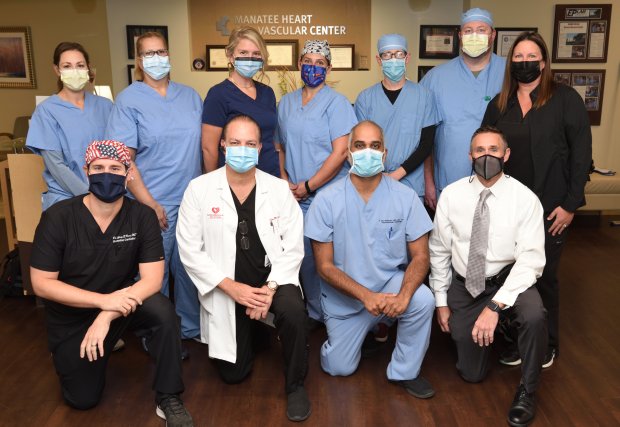Manatee Memorial Hospital Offering Shockwave Technology to Treat Calcified Coronary Plaque

Manatee Memorial Hospital is now offering severely calcified coronary artery disease patients a new treatment option that uses sonic pressure waves to safely break up calcium blockage that can reduce blood flow in the heart.
The new shockwave technology, also known as intravascular lithotripsy or IVL, enables physicians to fracture the problematic calcium using sonic pressure waves so the artery can be safely expanded, and blood flow is restored with the placement of a stent and without unnecessary complications.
Heart and Vascular Services
Learn more about the heart and vascular services at Manatee Memorial Hospital →
S. Jay Mathews, MD, performed the first case with our Heart and Vascular team in August. James Nguyen, MD, Anthony Pizzo, MD, Enrique Rivera, MD, Jeffrey Rossi, MD, and Gino Sedillo, MD, are also trained in this procedure. Currently the hospital has completed 55 procedures.
“Our cardiology team is steadfast in our commitment to give our patients access to the latest cardiovascular innovations to treat heart disease,” said Tom McDougal, CEO, Manatee Memorial Hospital. “It is exciting to be able to offer this treatment option to our patients with severely calcified coronary artery disease.”
Heart disease is the leading cause of death for both men and women.1 Each year, more than 600,000 people in the United States die of heart disease. As people with heart disease, specifically coronary artery disease, grow older and their disease progresses, plaque in the arteries evolves into calcium deposits, which can narrow the artery. Physicians often use stents to open an artery, and of the approximately one million patients that undergo a stent procedure each year, 30 percent have problematic calcium that increases their risk for adverse events.2
Calcium makes the artery rigid and more difficult to reopen with conventional treatments, including balloons, which attempt to crack the calcium when inflated to high pressure, and atherectomy, which drills through the calcium to open the artery.3
While atherectomy has been available for several decades, its use remains low, as it can result in complications for patients who are undergoing stent procedures.3
2 Généreux P, et al. JACC 2014; 63(18);1845-54
3 Hill J., Kereiakes D., et al. IVL for Severely Calcified Coronary Artery Disease. J Am Coll Cardiol. 2020 Dec, 76 (22) 2635–2646. https://www.jacc.org/doi/full/10.1016/j.jacc.2020.09.603
